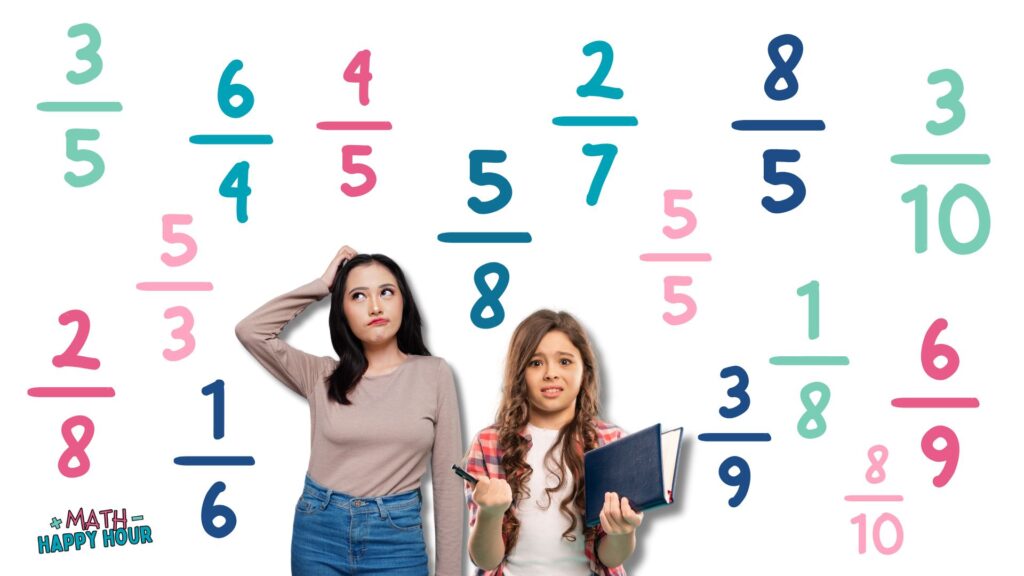Browse around
topics
Hey Friend!
Elementary Teachers who love talking about math.
We're Tiana & Whitney
Teaching math was not our favorite. We taught math traditionally with memorized steps and timed tests because we didn't know math could be fun. Read our story
The Power of Think-Time During Math Talks
Math Talks
Enhancing Math Conversations: Using Talk Posters Effectively
Math Talks
Build Multiplication Fluency with Visual Arrays
Fluency + Fun
Celebrating the Brilliance of Every Student in Math
Teacher Toolbox
Let's get Social!
Follow us on Instagram for the latest math tools and strategies!
My Fraction Struggles (and What I Wish I Knew Sooner)
I used to think I just wasn’t good at fractions. Sound familiar? For years, I struggled to make sense of them, and honestly, I carried that math baggage into my teaching.
It wasn’t until I went through Cognitively Guided Instruction (CGI) training that I realized—my struggles weren’t because fractions were too hard. It was because I was never taught to truly understand them. This is why we need to change the mindset around teaching fractions and debunk some fraction misconceptions.
I had memorized procedures without grasping the why behind them.
And that changed everything.
Now, I see fraction misconceptions all the time—both from teachers and students.
The good news? Once you understand these myths, you can shift your instruction to help students develop real fraction sense, build number flexibility, and become confident problem-solvers.
Let’s dive into some of the biggest fraction misconceptions and what we can do instead!
Myth #1: “I’m Not Good at Fractions”
That used to be me! But here’s the thing: if we tell ourselves (or our students) that fractions are hard, we’re reinforcing a negative mindset.
Instead, approach fractions with curiosity and excitement. Your enthusiasm is contagious! Even if fractions were tricky for you in school, you can rewrite that narrative for yourself and your students.

Myth #2: Kids Can’t Learn Fractions Until 3rd Grade
Not true! Young children naturally explore fractions through everyday experiences. Ever given a child a cookie and asked them to share it fairly? They figure out how to split it into two equal parts on their own. This is the foundation of fractions!
We can start laying the groundwork in kindergarten (or earlier) by using real-world experiences with sharing, cutting, and dividing objects.
Myth #3: Kids Need to Learn Fraction Symbols First
Stop! Kids should build meaning before they see the fraction notation. The symbols (1/2, 1/3, 3/4) can be confusing if students don’t already have a solid understanding of what fractions represent.
Start with hands-on experiences and verbal explanations. Instead of jumping to 1/2, say, “When we split something into two equal parts, we call those halves. This is one-half.” Once students understand fraction concepts, then introduce the symbolic notation.

Myth #4: Word Problems Are Harder Than Equations
Actually, word problems are often easier for students because they connect to real life. If we ask students to evenly share five cookies among two people, they can see what needs to happen and use their natural problem-solving skills. They might not know how to write or name the fraction initally, but they can solve it using logic.
Starting with sharing problems builds strong fraction understanding without needing formal instruction on “how” to solve them.
Want to try some equal sharing stories to use in your classroom to build meaning around fractions? Grab our 12 free fraction math stories.
Myth #5: Kids Need to Memorize Steps to Operate with Fractions
Would you believe that kids can add, subtract, multiply, and divide fractions without memorizing steps? The key is building a strong conceptual foundation first.
In elementary school, students should focus on understanding fractions through real-world contexts before learning procedures. When students deeply understand fractions, they can figure out operations naturally instead of just memorizing steps.

Myth #6: Fraction Strips Are the Best Ways to Teach Fractions
Be careful! Some common fraction tools, like fraction strips, can actually create misconceptions. If fraction strips aren’t aligned correctly, a half can appear equivalent to five-ninths!
Instead of relying on pre-made visuals, have students draw their own models, cut out shapes, and physically manipulate their own fraction representations. This deepens understanding in a way that pre-made tools often don’t.
Myth #7: Kids Can Learn Fractions in Any Order
Teaching fractions in a logical progression helps students make sense of them. Start with halves and fourths—these are the easiest for kids to grasp because they see them most often in real life. Then introduce thirds, followed by other unit fractions (like sixths and eighths).
Strong understanding of unit fractions (fractions with 1 in the numerator) is essential before moving on to more complex fraction concepts.
Final Thoughts: What This Means for Your Teaching
Understanding these fraction misconceptions can transform your math instruction. By focusing on real-world connections, building conceptual understanding before introducing symbols, and encouraging problem-solving over memorization, we can help students develop strong number sense and confidence with fractions.
So next time you hear a student say, “I’m not good at fractions,” remind them (and yourself!) that fractions aren’t about being “good” or “bad” at math. They’re about making sense of numbers in a way that’s meaningful and intuitive. And when we teach fractions with understanding at the center, every student can be successful.
P.S. Want to try a game-changing fractions activity in your classroom? Start with an equal-sharing story problem and see what your students come up with before offering any guidance. Grab our 12 Equal Sharing Stories resource and try them in your classroom tomorrow. You’ll be amazed at how much they already understand!
Pin
Share
Leave a Reply Cancel reply
Previous Story
next Story
© 2025 Math Happy Hour. Site by Sugar Studios
Heard about Math Talks but unsure where to begin? 🤷♀️ Don't stress!
5 Steps to Get Started with Math Talks
Join us on Insta
We're so glad you're here, stick around and let's talk about math! xo Whitney & Tiana
